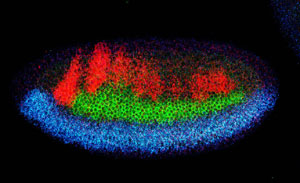Mechanism to Organize Nervous System Conserved in Evolution
September 11, 2006
By Sherry Seethaler
A study led by University of California, San Diego biologists suggests that, contrary to the prevailing view, the process in early development that partitions the nervous system in fruit flies and vertebrates, like humans, evolved from a common ancestor.
In the September 12 issue of the journal Public Library of Science Biology, the researchers report that in both fruit fly and chick embryos proteins called BMPs play similar roles in telling cells in the early embryo to switch certain genes on and off, specifying the identity of the cells making up the three primary subdivisions of the central nervous system. The findings suggest a unified model of early neural development in which at least part of the mechanism for creating neural patterning has been preserved from a shared ancestral organism that lived over 500 million years ago.

Fruit fly embryo with colors indicating a localized perturbation in the activation of three genes that determine neural identities. Credit: Mieko Mizutani, UCSD
"We have provided the first evidence for a common role of BMPs in establishing the pattern of gene expression along the dorsal-ventral axis of the nervous system of vertebrates and invertebrates," said Ethan Bier, a professor of biology at UCSD and senior author on the study. "Our results suggest that this process has been conserved from a common ancestor rather than evolving separately as had been previously believed."
Early in the development of a complex organism, when it is a ball of indistinguishable cells, BMP gradients are responsible for partitioning embryos into neural and non-neural tissue. During this phase, often referred to as neural induction, high levels of BMPs in non-neural regions actively suppress neural development. This role of BMPs is one of the best examples of a conserved evolutionary process.
However, it has been less clear whether BMPs also play a common role in further subdividing the nerve tissue into three distinct regions. Although the so-called neural identity genes get switched on in a similar pattern in relation to the BMP source, it has been speculated that distinct mechanisms operate to determine those activation patterns in fruit flies versus vertebrates. For example, in vertebrates a protein called Hedgehog is a key patterning agent in this process, while in flies a gradient of a different protein called Dorsal plays a comparable role.
"Because of the dominant role of the gradient of Dorsal protein, it has not been possible to directly test the role of BMPs in patterning nerve tissue in fruit flies." explained Mieko Mizutani, a postdoctoral researcher in biology at UCSD and the lead author on the paper. "Eliminating Dorsal results in embryos that do not have any nerve tissue. Therefore, we had to genetically reconstruct embryos that had a uniform concentration of Dorsal throughout. Then we could examine how neural patterning was affected by a BMP gradient. The techniques took approximately fours years to develop and will also be useful for future research to understand how the many genes of the genome are turned on or off in groups."
In these embryos with a uniform concentration of Dorsal, the researchers switched on the gene for the fruit fly BMP in a narrow stripe. Using a technique called multiplex labeling that Bier, Mizutani and fellow UCSD biologists developed two years ago, Mizutani was able to use different colored fluorescent molecules to determine which neural identity genes were activated in response to the BMP gradient. She determined that BMPs acted the same way as they do earlier during neural induction, namely to shut off neural identity genes. Because BMPs can shut some neural genes off better than others, the pattern in which the neural identity genes get switched off depends on the concentration of BMP.
The finding that a BMP gradient controlled neural development in fruit flies prompted the authors to ask whether the same might be true in vertebrates. Bier and Mizutani collaborated with Henk Roelink, a professor of biology at the University of Washington, Seattle and his graduate student N�va Meyer. They performed analogous experiments on chick embryos.
Roelink and Meyer added doses of BMP to a Petri plate containing nerve tissue from early chick embryos. As with fruit flies, they had to hold constant the concentration of another protein involved in dorsal-ventral patterning (in this case Hedgehog rather than Dorsal). The neural identity genes in chick responded to the BMP gradient just as their counterparts responded in fruit flies. "Our findings suggest that BMPs may once have been sufficient to organize the entire dorsal-ventral axis of a common ancestor," concluded Bier.
"BMPs and the neural identity genes appear to have been conserved in evolution, while other cues such as Dorsal in flies and Hedgehog in vertebrates may have been borrowed from other pattern systems after the split between vertebrate and invertebrate lineages. As larger organisms evolved, the gradient of a single protein may not have been able to provide sufficient information to subdivide the embryo from top to bottom."
This study was funded by the National Institutes of Health and the National Science Foundation.
Media Contact: Sherry Seethaler, (858) 534-4656
Comment: Ethan Bier (858) 534-8792
